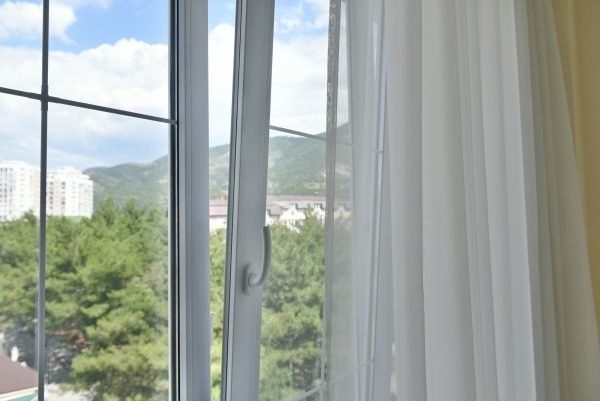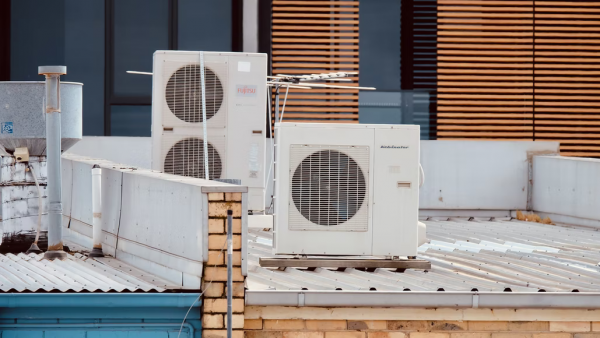
The plastic window is open. Open window with curtains and mountain views.
You’re looking for different home improvement projects to do around the house. There are lots of different options available, but one that’s probably at the back of your mind is improving the ventilation.
Effectively, your home’s ventilation is its ability to disperse air around. A well-ventilated home will move air around and disperse it outside the property with no issues. On the flip side, a poorly-ventilated home could be very stuffy, have stale air floating around, and lead to a number of issues.
So, this post will focus on two separate things. Firstly, why is it so crucial to improve home ventilation? After learning about this, you’ll find a host of tips that will help you achieve an excellently-ventilated property!
Why home ventilation is important
As mentioned in the introduction, the purpose of ventilation is to move air around your home. Doing so will help you get rid of the following:
- Airborne allergens
- Chemicals
- Moisture
- Odors
- Pollutants
Consequently, a well-ventilated property will give you these amazing benefits:
Healthier air inside the home
Getting rid of things like dust and other airborne allergens will make the air in your home easier to breathe. It creates a healthier environment that’s better for people suffering from seasonal allergies – or other airborne allergies. They will see a reduction in common symptoms, like blocked noses, itchy eyes, and sore throats.
Likewise, think about the chemicals and other pollutants you may release in your home. When you clean your house – particularly in places like the bathroom or kitchen – you could use bleach or other chemicals that release toxins into the air. A good ventilation system will take these harmful things and disperse them outside. Thus, the air is healthier and has less chance of causing extra health problems.
A lower chance of water damage
A lot of homeowners will experience water damage at some point. Contrary to popular belief, you don’t need to be hit by a flood to require a restoration service for water damage in the home. In fact, the most common cause of water damage comes from poor ventilation.
You see, a poorly-ventilated property won’t be good at removing steam or hot air. Therefore, this air hits the walls or ceiling and condenses, leaving moisture sitting there. From here, the moisture settles in and creates damp conditions that lead to mold and rot. As such, you’ll need to fork out a lot of cash on mold removal or water damage restoration. When your property has a good ventilation system in place, all of the hot air will dissipate outside. You don’t get condensation, and the inside of your house stays nice and dry.
A home that smells nice and fresh
Lastly, ventilation gets rid of all the nasty odors in your house. If you kept every single window and door closed in your home, it will smell really musty and nasty. Let’s be honest, you’ve experienced this many times before. If you have a particularly sweaty night, you wake up in the morning and the air in the bedroom almost feels thick and smells a bit stale. Opening the windows helps to get fresh air into your home while bad odors leave.
To summarize, you need to improve home ventilation to enjoy a house that smells nicer, has healthier air to breathe in, and won’t fall victim to water damage/mold. Right, this brings us to the big question…
How do you improve home ventilation?
You’ll be pleased to know that improving home ventilation is much easier than you think. This isn’t a task that requires a huge amount of effort or investment. Sure, there are tips below that will suggest you buy certain things to improve ventilation, but it’s up to you to decide what lengths you need to go to.
Keeping all of that in mind, here are the top tips:

#1 Open doors & windows
This was something we very briefly touched upon a few paragraphs ago, but it’s the simplest way to instantly see improvements in ventilation.
The problem most households have is they keep the windows and doors shut too often – especially in winter. Yes, you want to keep your home warm, but you need to ventilate it and get fresh air inside. Opening your windows for a couple of hours a day in the morning will help you get rid of stale air, bring fresh air into your home, and really decrease the humidity at the same time.
If you have to pop to the shops or take the kids to work, this is the perfect time to leave your windows open just a little bit. When you return, you will be amazed at how much fresher your home feels and smells.
Another pro tip is to put some fans next to the windows as this helps to blow more air out of your home, boosting the ventilation effect.
#2 Use your exhaust fans
Sometimes called extraction fans, these fans come in every single home these days. They are literally designed to help extract air and transport it outside. You will typically find them in the two rooms most guilty of generating a lot of hot air and humidity: the bathroom and kitchen.
In your kitchen, the exhaust fan usually sits above the cooker, helping to suck up steam while you cook. Always turn it on when cooking to stop your home from getting full of really hot and humid air that may lead to water damage. The same goes for your bathroom – this fan needs to be on whenever you shower or run the bath. It’s also a good idea to have it on when going to the toilet as it does help you get rid of some bad smells!
There’s a really easy and cool way to see just how effective these fans can be. Take a shower without the fan on and look at how foggy your bathroom mirror gets. The next day, take a shower with the fan on, and you should see a distinct difference. Just make sure you keep the fan clean as it can sometimes get clogged with dust, making it ineffective. Every month or so, remove the fan and clean it out.
#3 Try to dry your clothes outside
Whenever this is possible, it will make a considerable difference to your home’s ventilation. Drying clothes inside will mean that so much moisture escapes from these clothes and gets into the air. The humidity levels rise uncontrollably, leading to dampness and mold.
If you have a dryer, you can dry your clothes in that. Granted, many of you are looking to cut down on your energy bills, so letting clothes dry by themselves will help you avoid turning on the dryer. That’s completely fair enough, so hang them outside if you have enough room. If you live in an apartment, you sometimes get communal clotheslines to dry your clothes outside. If not, don’t worry, the next tip can also prove useful when drying your clothes indoors.
#4 Buy a dehumidifier & air purifier
Two products are very effective at improving ventilation in your home. A dehumidifier works by extracting moisture from the air. You can turn it on whenever you like to decrease humidity levels and ventilate your home – much in the same way as an exhaust fan. It’s also handy for drying clothes very quickly indoors as it sucks the moisture from them. So, if you don’t have space to dry clothes outside, this is a great alternative.
An air purifier will take allergens and other pollutants out of the air. It filters the air through the machine, removing these things and filling your home with cleaner air. This is one of those products you have to see in action to believe. It sounds ridiculous, but your air genuinely feels healthier after using a purifier for a few days.
#5 Use an HVAC system
Some homes will already have a heating, ventilation, and air conditioning system installed. If this is the case, you will have air ducts throughout your home that can be used to filter air through.
All you have to do is set your HVAC fan to on, so it runs and extracts air from your property, drastically improving ventilation. Effectively, you end up with an exhaust fan in every single room, with the added benefit of a filter to filter out harmful pollutants or airborne allergens.
If you do not have one of these systems in your house, you may consider installing one. It’s a good idea if you also need air conditioning during the summer months. Here, you can combine your heating, air conditioning, and ventilation all into one.
How do you know if your home isn’t well-ventilated? For starters, it will always smell a bit sour and stale, and you may constantly have a stuffy nose. Likewise, you could check the humidity – and if it is above 75% regularly, then there’s too much moisture in your home. Follow the tips above, and you will see massive improvements in ventilation, leading to a healthier and better property.

Speak Your Mind